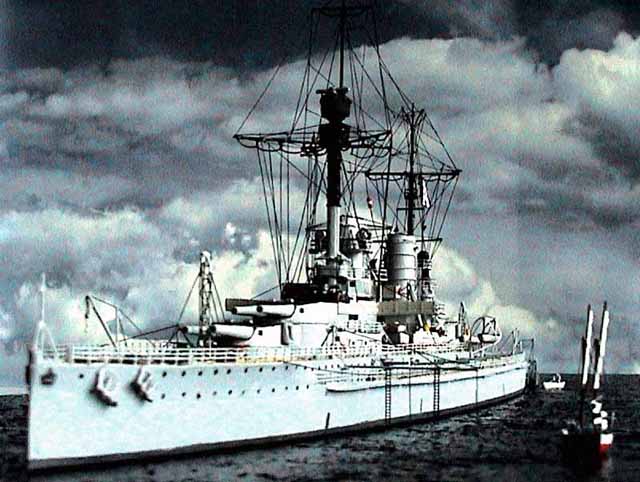by Dariusz Mazurowski

1/700 SMS Konig (HP Model)

I have several HP Models kits in my collection their quality varies from pretty good (M-50 minesweeper) to really bad. Unfortunately with the SMS Konig on the lower end of above said ranking. But if You want her 1/700 model, it's the only game in town. Couple years ago ICM released excellent 1/350 plastic kit, certainly one of the best of it's kind but far too big for me (twice…). WSW has announced their kit, Ive been told also that Kombrig has been going to put their version if same quality as latest efforts, could be a winner… But who wants to wait ? Not me… HP Models kit has lots of flaws, but the greatest are :
The only benefit is that You get a starting point with basically accurate dimensions. So, my first impression after opening the box was : it's useless, I can't do anything with stuff like that ! The second : take it easy and don't give up. Finally I've used only heavily modified hull (with sanded and restored deck), main turrets and two biggest parts of superstructure supplemented with spare parts from previous projects including WSW motorboats, searchlights and AA guns (8,8 cm). My fault I've decided to use original 30,5 cm barrels. HP Models version has incorrect shape and is far to thick. NNT offers excellent brass barrels (both 30,5 and 15 cm), but to be honest I've had enough of this project kit and wanted to finish her as soon as possible. Well modeler should be more patient…
Besides above said parts I've used also photo etched frets, mostly from GMM. The rest (superstructure, platforms, bridges, cranes, masts etc.) has been built from the scratch. Rigging thin copper wire, water acrylic paint (Prussian Blue) with warnish.
To complete the diorama I add some boats (including Barkasse kl. 0 with masts) and tug Wendemuth built entirely from scratch (which has been much more fun than battleship completion BTW).
SMS Konig
The four ships of the Konig class were the last Imperial German battleships with 30,5 cm main guns. As the successors of the Kaiser class these ships had some important improvements, including the most significant all main turrets in a centerline. Very powerful, well armored ships were the core of the Hochseeflotte and took part in most major naval operations during WWI (including Battle of Jutland and Operation Albion). Overall a very successful design, even with 30,5 cm artillery (contemporary British battleships had 34,3 or 38,1 cm guns, but Konigs were much better armored and had oudstanding underwater protection). Konig was scuttled in 1919 at Scapa Flow and still remain there today, being a local attraction for diving enthusiasts.
Technical data
Displacement (construction/full) : 25 796 / 28 600 t
Dimensions : length (CWL / overall) : 174,70 / 175,40 m
beam : 29,50 m (without anti-torpedo nets)
draft (construction / maximum) : 9,00 / 9,19 m
Armor :
belt 350 mm,
citadell 180 mm,
casemates 170 mm,
deck 30 mm,
turrets 300 mm (front), 150 mm (rear), 250 300 mm (sides), 80 110 mm
(roof)
main command tower 300 mm (vertical), 150 (horizontal),
aft command tower 200 mm (vertical), 50 mm (horizontal).
Overall armor weight : 10 440 t (according to Evers), or 10 450 t (Koop & Schmolke publication).
Engines (3 steam turbines, 3 shafts) 31 000 WPS, maximum speed 21 knots (official figure,
acording to most sources could easily steam up to 24 knots). 3 oil fired and 12 coal fired boilers.
Coal : 850 t (normal), 3 000 t (maximum). Oil : 150 t (normal), 600 t (maximum).
Range : 8 000 miles (12 knots), 4 000 miles (18 knots).
Armament (1918) : 10 x 30,5 cm L/50, 14 x 15 cm L/45, 4 x 8,8 cm L/45 Flak (AA), 5 torpedo tubes 50 cm (underwater 1 bow, 4 side)
Crew : 41 officers and 1 095 men plus 2 officers and 24 men (as squadron flagship)
Laid down 03.10.1911, launched 01.03.1913, commissioned 10.08.1914
Built by Kaiserliche Werft, Wilhelmshaven (yard number 33)
Wendemuth history & data She was built in 1913 by Jos. L. Meyer shipyard (Papenburg) for HAPAG (Hamburg-Amerikanische Packetfahrt Actien-Gesellschaft). Wendemuth and her sister ship Loewer (commissioned in 1914) were designed to assist Imperator class liners. Name ship of the class and her younger sister Vaterland were the biggest ships then (and perhaps the most elegant and luxurious), so it was necessary to own very powerful and big tugs also.
Sometimes size really matters....
9.01.1915 Wendemuth was mobilized, but shortly after that again returned to the owner (5.02.1915). Her war service was rather unsignificant, but when battleship Rheinland ran aground in the Aaland Sea (april 1918), she took part in a rescue operation.
After the war both sisters were slightly modified (inc. aft mast and small cabin for passengers) and sold (in 1929) to Norddeutschen Lloyd. Wendemuth was renamed to Vulkan and Loewer to Merkur. In 1934 Merkur was badly damaged by Albert Ballin liner and sank. Vulkan (former Wendemuth) had a longer life she hit a mine in september 1944, near Le Havre, and sank.
